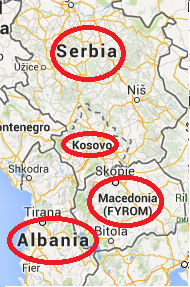 While reading about the places we would be visiting during our trip to the Balkans, Ohrid in Macedonia really stood out. It seemed to have many of the things we like in a city and it didn’t disappoint. Most of the main sites are walkable (not so easy though due to the hills) and the area is filled with lots of things to do.
While reading about the places we would be visiting during our trip to the Balkans, Ohrid in Macedonia really stood out. It seemed to have many of the things we like in a city and it didn’t disappoint. Most of the main sites are walkable (not so easy though due to the hills) and the area is filled with lots of things to do.
Ohrid is a UNESCO World Heritage Site due to the beautiful Lake Ohrid and for it’s ancient churches, icons and well preserved achitecture and streets.
We had a great time exploring the area and it has probably been our favorite part of the trip so far.
Here are some of the things we did:
- Seeing paper get made at The Handmade Paper Workshop
- Getting into the well-hidden Small St. Klement Church
- Boat ride & swimming on Lake Ohrid
- Great views from King Samoli Fortress
- Mosaics in the Christian Basilica at Plaoshnik
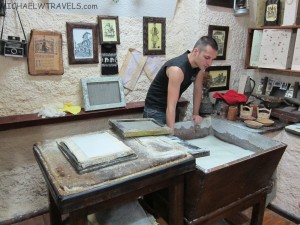 I can’t say that I’ve ever seen paper get made by hand until visiting The Handmade Paper Workshop. It’s one of seven shops in the world still using a Guttenberg Press (not an original). When we stopped in the shop we were explained the process of paper making and then shown how it is done.
I can’t say that I’ve ever seen paper get made by hand until visiting The Handmade Paper Workshop. It’s one of seven shops in the world still using a Guttenberg Press (not an original). When we stopped in the shop we were explained the process of paper making and then shown how it is done.
Small wood pieces are placed into water where it breaks down . The guy then placed a thing looking like a strainer into the water. The whole area filled with the tiny wood particles allowing the water to drain out. He then turned the strainer over onto a mat leaving a wet piece of paper. After drying for a while it is then brought outside onto a drying rack for it to finish the process.
It was definitely an interesting process to see done. Admission is free and you can buy some paper as a souvenir. Some have prints from the Guttenberg Press on them too.
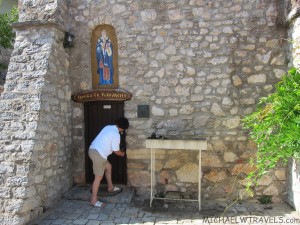 Finding Small St. Klement Church and getting access inside was most of the fun involved in our visit. The church is well hidden on one of the original streets in the city. We had read that to get inside, we’d have to ring a neighbors bell and ask for a key.
Finding Small St. Klement Church and getting access inside was most of the fun involved in our visit. The church is well hidden on one of the original streets in the city. We had read that to get inside, we’d have to ring a neighbors bell and ask for a key.
After looking around for a few minutes we gave in and asked a guy in a shop nearby for directions. He was helpful and told us (like we had read) that to get in we’d have to knock on one of the home’s doors and ask for the key. When we got to the area, we first went and looked for the church. We found it and thought it was interesting how it didn’t resemble a typical church from the outside.
I hesitated before ringing the bell but within a moment a nice older lady answered the door and came with us to open the church.
The church was very old and had some amazing frescos inside but the real fun here was just getting inside!
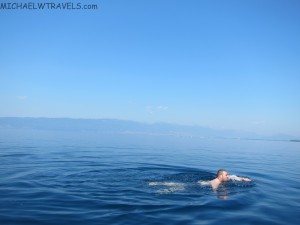 Lake Ohrid is one of the deepest and oldest lakes in Europe. When looking at the lake from shore all you see is bright blue. We took a boat ride on the lake which was given by the owner of the guest house we stayed at during our time in the area.
Lake Ohrid is one of the deepest and oldest lakes in Europe. When looking at the lake from shore all you see is bright blue. We took a boat ride on the lake which was given by the owner of the guest house we stayed at during our time in the area.
Our first stop was to the Hydrobiological Institute to see the endangered Ohrid trout which are endemic to the lake. Thanks in part to a breeding program and limits on fishing, we were told that the species is doing better now.
After our visit we went for a ride on the lake. The views of the old town of Ohrid and some of the local beaches were really great. Visiting the lake by boat really puts in perspective just how big it is. The water is crystal clear and you can see all of the way to the bottom in shallow water. The highlight of our visit was getting to go for a swim. I dove in from the boat and when I looked down all I saw was bright blue. The water was a bit chilly but felt really refreshing after being on the boat for over an hour.
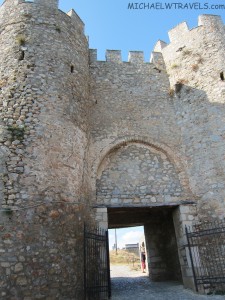 Visiting another Balkan city meant stopping by another fortress. We were close to passing on a visit to the King Samoli Fortress but were glad we didn’t. This fortress was different from all of the others and also quite a bit smaller. Once inside the gates, there are staircases allowing visitors acces to the top of about half the walls. From the top the views of the lake and city are excellent.
Visiting another Balkan city meant stopping by another fortress. We were close to passing on a visit to the King Samoli Fortress but were glad we didn’t. This fortress was different from all of the others and also quite a bit smaller. Once inside the gates, there are staircases allowing visitors acces to the top of about half the walls. From the top the views of the lake and city are excellent.
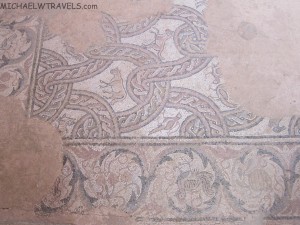 We were amazed by the amount of well preserved mosaics at the Christian Basilica at Plaoshnik. From a distance all you see is an open space covered with a red roof but once you go inside, you’ll be amazed. A wooden foot bridge is about 4-5 feet off the ground which allows visitors to walk all around the basilica without stepping on or interrupting the amazing artwork on the floors. The mosaics we saw had many intricate patterns as well as depicted various animals.
We were amazed by the amount of well preserved mosaics at the Christian Basilica at Plaoshnik. From a distance all you see is an open space covered with a red roof but once you go inside, you’ll be amazed. A wooden foot bridge is about 4-5 feet off the ground which allows visitors to walk all around the basilica without stepping on or interrupting the amazing artwork on the floors. The mosaics we saw had many intricate patterns as well as depicted various animals.
Although I’m not a huge fan of art, these mosaics were pretty amazing to see.
Keep checking back for more about our trip to the Balkans. Our next stop is Albania!
Check out my other posts about our trip:
- Day 1- Belgrade, Serbia
- Day 2- Novi Sad, Serbia
- Day 3- Nis, Serbia
- Days 4 & 5- Skopje, Macedonia
- Day 6- Kosovo
- Balkans Trip: Lucas finally gets an airline duck
- Balkans Trip: Some Local Menu Item at McDonald’s in Serbia
Just wanted to say thanks for posting about some “different” places. I don’t know that the Balkans are for me at where I am in life (and in this hobby), but it’s inspiring
I really appreciate the kind words and am glad that you are enjoying my posts! The Balkans definitely are not for everyone. If you haven’t been to lots of other places in Europe, I probably would not recommend it (or at least these particular countries).
What an amazing journey this is! I am smiling more and more each day as you post. The lake looks amazing (was the water warm?)!
Thanks Rene! It’s been a great trip so far. The water was actually a bit chilly at first but it felt great.